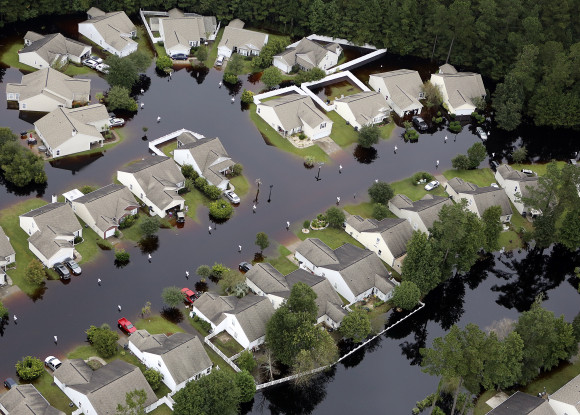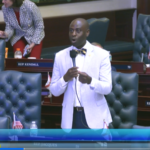Unleashing the invisible hand that has been missing from the flood insurance market for nearly 50 years is no easy task. But private flood insurance experts say the change would be a good thing not only for private flood insurers but also for consumers.
How much and how fast the private market for flood coverage will change depends on what Congress does to overhaul of the current federal program, the National Flood Insurance Program (NFIP), which expires on Sept. 30. The House and Senate are both working on legislation that would reauthorize the NFIP and introduce reforms that include changes to encourage private insurance. There appears to be bipartisan agreement on encouraging more of a private market, although there is some disagreement over how to go about it.
Some private insurers and brokers are enthused about the potential.
“It is inevitable that the private market will assume the dominant position of flood (insurance) in the United States,” claims Craig Poulton, CEO of Salt Lake City-based Poulton Associates, which administers one of the largest U.S. private flood insurance programs, the Natural Catastrophe Insurance Program, at CATcoverage.com.
Poulton believes that a vibrant private market will drive out waste in the NFIP. “When you look at how much of each dollar is available to pay a claim and what is paid in, you understand why there’s a $24 billion deficit,” he said.
The deficit continues to grow, he added. In January, the Federal Emergency Management Agency (FEMA) again announced that the NFIP would need to borrow another $1.6 billion from the U.S. Treasury to break even on its 2016 losses. Add that to the existing debt, largely due to hurricanes Katrina and Rita and Superstorm Sandy, and the NFIP currently is roughly $25 billion in debt.
Taxpayers in every state where flooding is not a major issue are demanding change, according to Poulton. Why? “Because enough is enough. Flood insurance is not special. Flood insurance is insurance. Flood insurance is just property insurance” and the private market should be insuring the risk, he said.
“Whatever works for homeowners [market] is going to work for flood. Let’s get it insured and let’s move forward,” he said. “Overall, both the NFIP and the private market will deliver lower rates if you unleash the invisible hand. That’s the way we see it, and we think we’ve demonstrated that.”
Uninsurable to Insurable
In the past, flood was considered an uninsurable risk for private market insurers.
“The reason that has been a generally accepted truth for many years, 50 years or so almost, is that we did not have the right information,” said Nancy Watkins, a principal consulting actuary for Milliman, an actuarial consulting firm in Seattle.
“Insurance companies for many years did not have that information, and they didn’t have any good way of measuring how risky a house was for flood peril. With catastrophe models over the last few years, and with a lot of big data sources coming available that didn’t used to be available, that problem has largely been reduced.”
The NFIP says it is not allowed by law to share its data. Data-sharing is among the issues addressed by the bills before Congress.
Another reason the private insurers have not jumped deep into flood waters is price.
“It was perceived — maybe true in some cases, maybe untrue in other cases — but it was generally perceived that the NFIPs rates were too low,” Watkins said.
“Without data to understand how risky a house was, and then having a suspicion that the NFIP’s prices were too low, there wasn’t much incentive [for carriers] to go in and try to offer coverage. Some companies did it anyway and have been doing it for many years, but most companies didn’t,” Watkins said.
Things are different now, according to Watkins and others. NFIP premiums are no longer low in all cases and insurers have new underwriting tools they can deploy.
“First of all, after the storms of 2005, Katrina especially, the NFIP built up a very big deficit and they started raising their premiums. That really made a big difference in terms of perception as to whether their premiums were too low or not,” she said. “Once the premiums got higher, more in the range of what a private insurer might be interested in charging, there became real opportunity for private market insurers.”
The second thing driving opportunity for a bigger and better private market is new and evolving catastrophe models. Carriers can now measure flood risk in much of the same way as they measure wildfire risk, earthquake risk, hurricane risk, etc. “They’re already used to these big disaster types of occurrences, but they didn’t have a model for flood. Now they have several models for flood.”
More Than the NFIP
While the NFIP insures about five million policyholders the opportunity for private market spans far beyond that, experts say.
There will always be a need and a place in the market for the NFIP, according to G. Michael Sloane, executive vice president and chief marketing officer of Wright Flood, one of the largest flood providers in the nation. Wright offers federal, excess and private flood insurance, rated A- (Excellent) by A.M. Best, and claims to have written the first-ever flood policy through the NFIP.
“We are strong believers that we will continue to grow the NFIP book and that marketplace will always be there. But we also have financial partners that allow us to be able to offer flood in the private market,” Sloane said. “We are going to go full throttle to continue to grow the NFIP book and provide a private flood alternative for those that want to pursue that course.”
Sloane doesn’t know how much of the NFIP book of business will be viable for the private market but he believes there’s no doubt that some could be moved out of the federal program. However, the real opportunity will come from outside of the NFIP, he said.
“What I think is going to happen and what is incumbent upon us as an industry and those that are offering a private flood alternative program is to grow that base outside of the NFIP, not just concentrate on what’s there already,” he said. “Some 25 percent of all flood losses happen in non-required flood zones, or what we call preferred risks. And that’s just those that have insurance. There are literally thousands more [properties] that didn’t have any type of coverage or thought they had coverage or didn’t understand coverage. That’s where we really have to grow as an industry and I think competition and the private market can help stimulate that more.”
Milliman’s Watkins says that opening up the insurance market should afford homeowners insurers an opportunity to offer existing policyholders broader and more complete property coverage.
“For an insurance company, one of the major opportunities is to offer more coverage to their existing policyholders that people really need,” she said. “Flood is not just a hurricane or a river. It’s just a lot of rain sometimes, and a lot of rain can happen anywhere. Or a pipe breaking down the street, and the water flows down the hill and gets into your house.
“It’s water that gets in, rising up from the ground, and that is not as unusual as many of the other perils that are already covered under homeowners insurance.”
Flood is an opportunity for homeowners insurers to provide coverage that people really need, she added. “It’s an opportunity [for the industry] to not have a black-eye when somebody’s man cave gets flooded in a bad rainstorm, and he thinks he has coverage, and then finds out that he doesn’t.” Flooding in basements is often excluded from a typical homeowners policy.
If insurers are able to properly price flood coverage, one or two man caves getting wet, is OK. “They can pay for it, because they collected premium for 98 other man caves that didn’t get wet,” she said. “All in all, they hopefully made a profit on it. That’s the way homeowners works.”
If insurers can sell flood to more of their existing policyholders, not just the riskiest properties, and bundle flood in with other coverages, then they’ve increased their premiums, while also increasing coverage for their policyholders, Watkins said.
Matt Herr, president and lead underwriter for Superior Flood Inc., also known as Flood Insurance Services, in Brighton, Colo., agrees that insurers are not just interested in cherry-picking the best risks from the NFIP. He says insurers are interested in providing a broader coverage flood product, at the right pricing structure in order to make a profit. He believes the insurance industry can deliver on that promise by reducing some of the cost that comes along with a government-run program.
“There’s a lot of overhead that we don’t have and that’s true with any private market side versus the forced NFIP policy or government‑run,” Kerr said. “There’s a lot of extra layers and layers and layers and layers [in the NFIP] and that money could be allocated on the FEMA side to pay for claims. On the Lloyd’s side, which we write the private [flood] through, we run lean and mean. We don’t have a lot of fat in the steak.”
Everybody Stands to Gain
Martin Hartley, executive vice president and chief operating officer of Florida-based PURE Insurance, says everyone stands to gain by opening up the flood insurance market but adds there is huge room for improvement all around.
“The NFIP does an excellent job at what it was originally designed for, but I think there is huge room for innovation and improvement,” Hartley said.
“Unleashing the private market [in flood] while keeping some presence in federal responsibility, policyholders will gain because there will certainly be more choice. There’ll be more competition. Different insurance companies will price risks differently and have a different view of risks. People can only benefit from that.”
Will insurance companies benefit? Sure, he says, but like any competitive product line the short-term view will be tight. “Short‑term, insurers may over‑compete, but I think ultimately it would probably benefit private enterprise.”
Hartley sees more product innovation occurring as more competition enters the market as well.
“Right now, in the private market, there is a lot of ‘me-too-ing’ of the NFIP. It’s the same coverage as the NFIP is writing. That’s just simpler, because it’s easier to get banks to approve a private market as the flood carrier to satisfy the mortgage requirements if the coverage is the same,” he said. “There isn’t a lot of creativity yet in how flood coverage is offered.”
People want to buy flood especially post-disaster.
“There is a great opportunity for the private market to come up with products that people want and to come up with service that people want,” he added.
Related:
- Private Insurers Cautiously Dip Toes Into Florida Flood Market Waters
- Milliman: Florida, Louisiana and Texas Would Benefit from Private Flood Insurance
- Study Shows Many Homeowners Would Do Better with Private Flood Insurance
- Mississippi Rep., Insurance Chief Urge Development of Private Flood Market
- House Committee Adds 5 More Bills to Its Flood Insurance Reform Package
- Flood Insurance in the Standard Market Part 1
- Flood Insurance in the Standard Market Part 2
- Powered by Homegrown Insurtech, HCI to Expand Flood Insurance Sales to 9 States
Topics Catastrophe USA Carriers Flood Market Homeowners
Was this article valuable?
Here are more articles you may enjoy.



 Did Florida House ‘Sneak’ Attorney Fee Wording Into Phosphate Mine Bill?
Did Florida House ‘Sneak’ Attorney Fee Wording Into Phosphate Mine Bill?  Father of Tesla Cybertruck Crash Victim Files Lawsuit Over Death
Father of Tesla Cybertruck Crash Victim Files Lawsuit Over Death  New York High Court Unleashes Expanded Liability for Pet Owners
New York High Court Unleashes Expanded Liability for Pet Owners  NJ Wildfire Update: 50% Contained; High Spread Risk Today; Suspect in Custody
NJ Wildfire Update: 50% Contained; High Spread Risk Today; Suspect in Custody 


